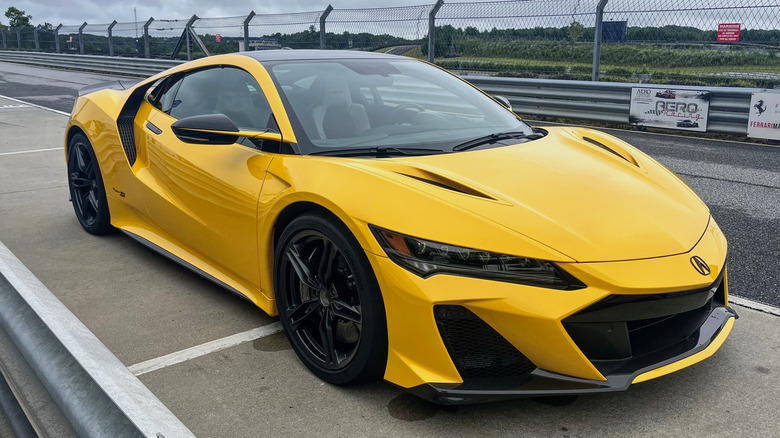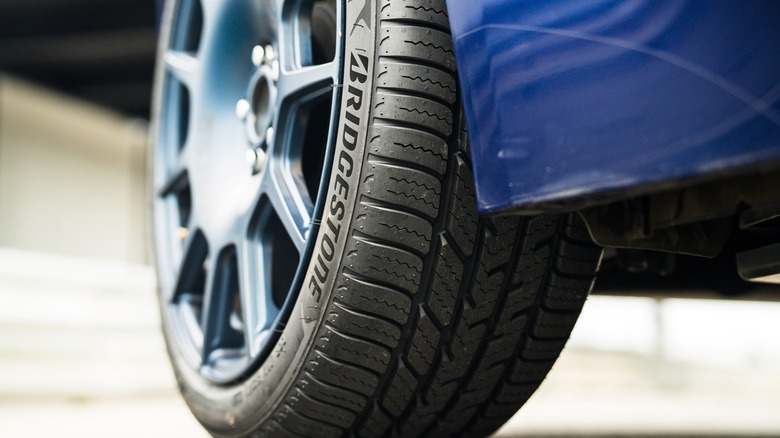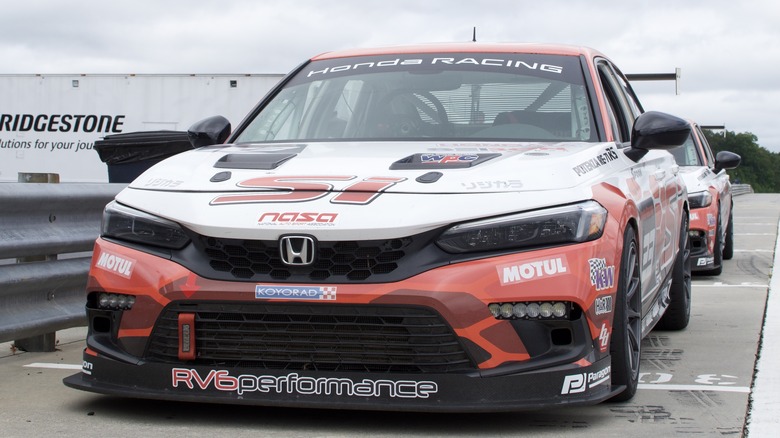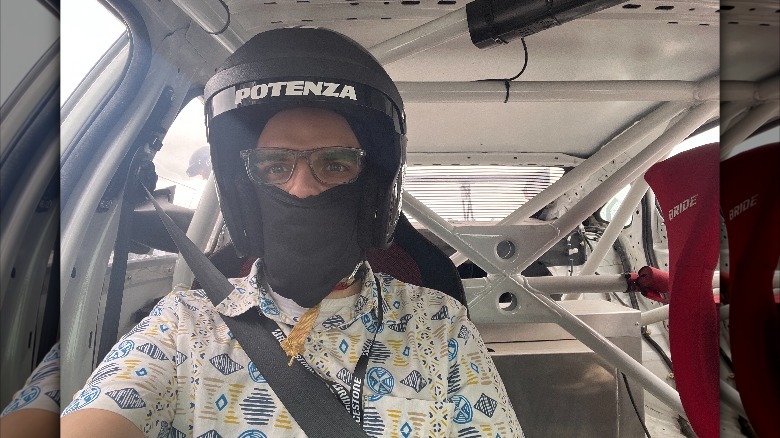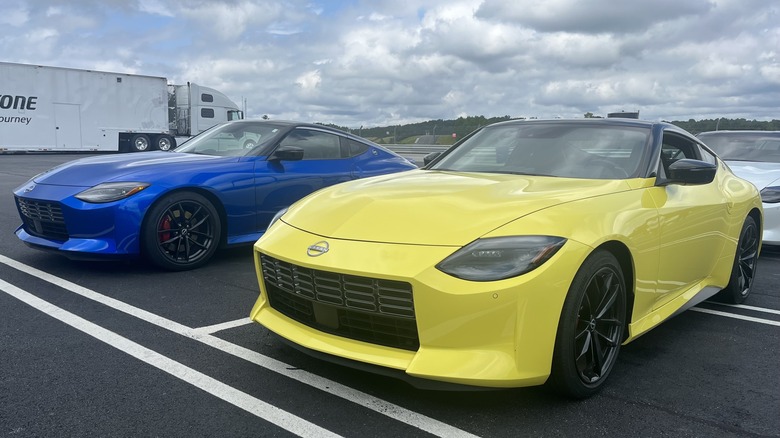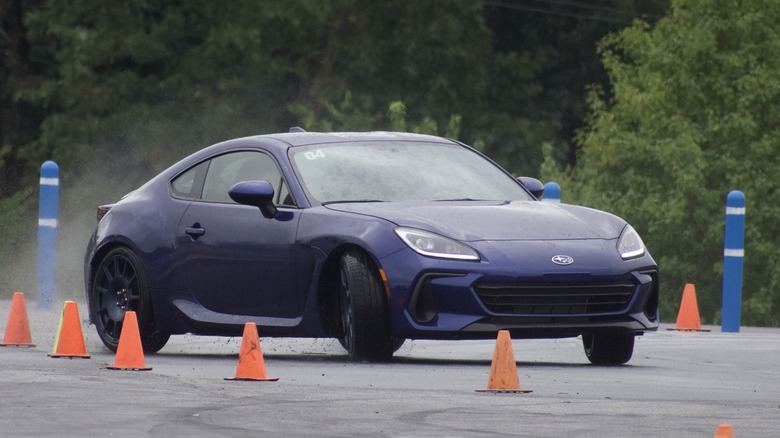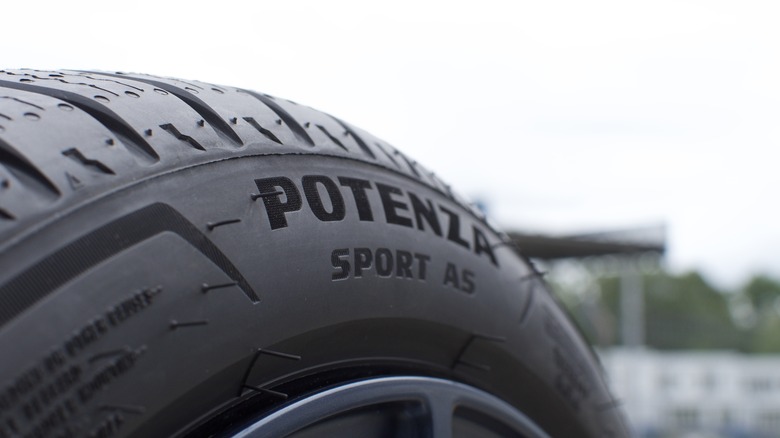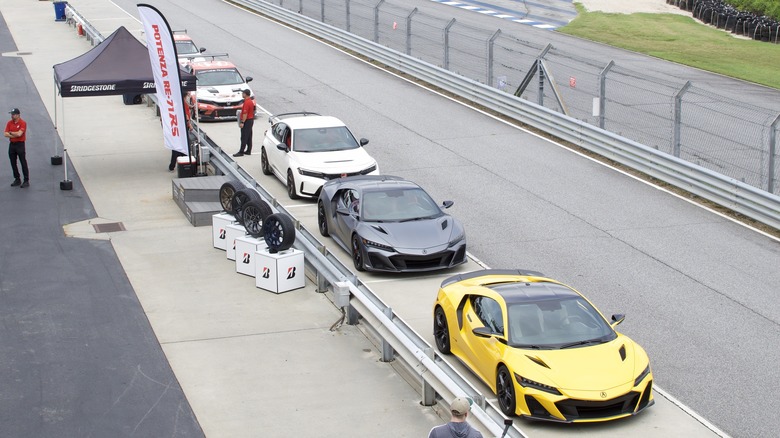Track Day Driving Acura's NSX Revealed The Big Upgrade That'll Improve Any Car
When looking at performance parts for a car, tires aren't always the most exciting to look at. It's easy to get worked up over a turbocharger or possibly a huge aerodynamic wing, or stripping every last possible ounce of weight off a car to make it lighter. But looking at tread pattern and rubber compounds can feel like going to the dentist: worth it, but ultimately a bit of a chore. That's exactly how I thought a little over a week ago, but Bridgestone managed to make me reconsider.
Bridgestone invited me to Atlanta Motorsports Park to try out its updated line of Potenza performance tires. I went in almost entirely blind and without much of an opinion on what tire brand was best, outside of "don't buy anything too cheap."
After spending several hours on the track and road with different sets of rubber on four wildly different cars, I can say without a doubt that tires are a more vital performance component than I gave them credit for, and are absolutely worth the time and money it takes to research and buy the perfect set for your car. After all, you could have the best race car in the world with unholy amounts of power, lightning fast transmission, and literal tons of downforce, but if you have a lousy set of tires, you won't be going that far.
Perfect tires for the perfect car
Prior to arriving in Atlanta, I had never driven on a track before, so this was an entirely new experience. Fortunately, Bridgestone had several drivers and instructors at the ready to bring me up to speed, both figuratively and literally. And the company couldn't have picked a better car for a first time track driver, none other than the Acura NSX Type S, the personification of everything Soichiro Honda, Acura, and the Performance Manufacturing Center in Ohio stands for. It's a 600-horsepower, near-$200,000 hybrid from space. What's not to like?
The NSX was fitted with a set of Bridgestone Potenza Race tires, specially suited for supercars and other high-performance automobiles. The Potenzas performed admirably whilst carving through all of Atlanta Motorsports Park's many tight corners. How would I know the tires performed well if I didn't have much of opinion beforehand? I noticed the total lack of noise or drama from the NSX, even as I was sawing at the wheel like my life depended on it. Despite an inexperienced driver (me) behind the wheel, the Acura never slipped, never squealed, or let off any indication that something was amiss.
Drama and noise might be fun at an Iron Maiden concert or while driving a Dodge Challenger Hellcat, but it's not exactly welcome when driving something like an NSX or while listening to an orchestra play Bach. That's partly due to Honda's impeccable engineering and also partly because Bridgestone picked the perfect tire for what we were driving. After all, it does say "Race" right on the tire. You wouldn't throw on any old rubber on a veritable supercar and expect it to perform well. The right tire can make a world of difference.
Race tires for a race car on a race track
After several laps around the track, I was strapped into the passenger seat of the next car Bridgestone picked for the showcase, a Honda Civic Si Race Car. And I'm not calling it a race car because it looks fast or sounded mean (it did), it's a literal race car with a roll cage, a fuel cell in the back, and nothing that could even be remotely described as an "interior." It was made right from the factory by Honda's Performance Division in Ohio to melt tires on the track and scare automotive writers. It succeeded at both.
While I was doing my best to remain composed and Honda's driver, Corey, was doing his best to pilot the car to as fast as he possibly could, the set of Bridgestone Potenza RE-71RSs gripped the pavement like it was going out of style and absolutely refused to make any noise under the extreme paces the Honda put it through. We hit 105 miles per hour going into a tight corner and while the Civic's 1.5-liter powerplant howled like a fighter jet, the RE-71s remained entirely unimpressed, like someone just started doing card tricks in front of it while it was trapped in an elevator.
The RE-71RS tires are unique in that they barely have any tread and probably aren't the best all-season tires for your average Honda Accord. But, when you're screaming down the back stretch in a car that doesn't even have any windows or a license plate, it's hard to imagine a better suited tire for the job.
Sport tires on a sport coupe
I'm fairly confident I lost about six-months off my lifespan and my face was in a fearful rictus grin for several hours after riding in the Civic Si, so the next car I had the opportunity to drive was a welcome change of pace. We were tasked with going on a roughly 26 mile cruise on Georgia's roads in a Nissan Z Performance. The Z is decidedly a more "normal" car than a supercar or literal race car, but that doesn't mean it wasn't up for any kind of winding road-related mischief (or, as much as the law allows). After all, it has 400 horsepower and mine was painted in a bright blue color that could likely be seen from space. Nissan calls it "Seiran Blue." My Z was set up with Potenza Sport tires.
As unfortunate as it is, I cannot fully attest to the Potenza Sport's capabilities: I was stuck behind a cement truck for the entirety of my drive with the Z and I never made it above 50 miles per hour, except for a scant few seconds. What was supposed to be a spirited jaunt through the twisty back roads of Dawson County, turned into a very slow cruise as the cement truck's speed typically hovered around 35 miles per hour. It's worth noting that the speed limit of nearly the entire route was 55 miles per hour.
Trying to lose traction in a BRZ
The last car and set of tires of the day were the real reason I was there. It was a Subaru BRZ and a set of the new Bridgestone Potenza Sport All-Seasons. While not as "normcore" as, say, a Toyota Corolla, a Subaru with all-seasons is decidedly a common sight, at least in theory. It was 85 degrees with approximately 1,000% humidity at the race track, so I was not able to test out the "All-Season" part of the tires, but the several sprinklers and water truck ensured that I would be able to try my darnedest to lose traction on the autocross course Bridgestone set up.
Much to the tire's credit, whenever the back end of the BRZ lost interest and decided to do its own thing, a flick of the steering wheel brought it back to attention. Thanks to the tires, very few of my several laps around the wet track seemed uncontrollable or too hairy. The BRZ makes 228 horsepower, enough to have fun but not at all earth shattering and, although it was rear-wheel drive, that's well within the horsepower range most people are dealing with for their commuter car. Once again, the ideal tire for that scenario.
Bridgestone's attainable sport tire
Out of the range of tires I tested, the Potenza Sport All-Seasons were decidedly directed towards a much wider sports car market. Not many people are going to be driving Civic Si race car (it's not even street legal) and anyone that has enough cash to drop on an NSX likely won't have much problem finding a nice set of tires. But for the rest of us with a Subaru BRZ budget, the Potenza Sport All-Seasons might be worth consideration.
According to Bridgestone, the tires are engineered to give a better balance of performance and long-life than previous tires. Meaning, in theory, that just because you drive a little more "dynamically," you won't absolutely trash your tires in a short period of time. They have a 50,000 mile warranty and are designed with aesthetics in mind, too, with huge text on the side reading "POTENZA." With an MRSP of $198.99 each, they'll be available in a total of 76 sizes between 16-inch and 22-inch wheels, with 48 offered right off the bat at launch and the remaining 28 sizes coming out in 2024.
You should care about tires
Much to Bridgestone's credit, all of the tires showcased performed incredibly well. The borderline race slick RE-71RSs gave the hopped-up Honda a solid strip of rubber to aid in its convincing impression of a slot car around the track. The Acura NSX Type S was complemented by the set of Potenza Race tires during its incredibly precise and exact time at Atlanta Motorsports Park. I'm disappointed that I didn't have a chance to experience much of the Nissan Z's Potenza Sport tires, but the Potenza Sport All-Seasons were confidence inspiring on the BRZ during my little autocross adventure.
But there are more tires in Bridgestone's lineup than Potenza, and there are many more tire brands than just Bridgestone. The most important takeaway is how the right tire can make a world of difference when considering what car it goes on, how you drive, and what weather you may come across. Not every tire is created equal and just because a tire is less expensive, doesn't mean it's worth buying. You wouldn't buy a car with a bad engine; similarly, you shouldn't buy bad tires. Your car's performance will suffer and your overall enjoyment of driving will probably be diminished.
